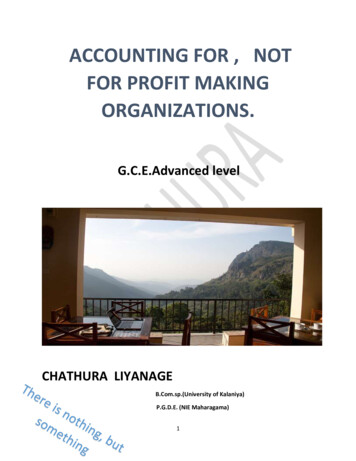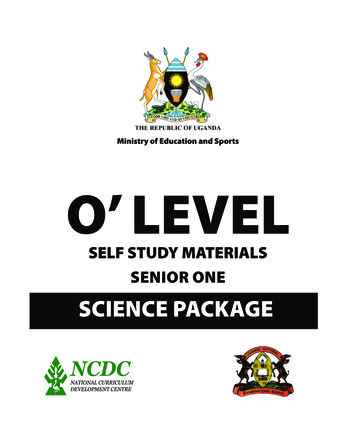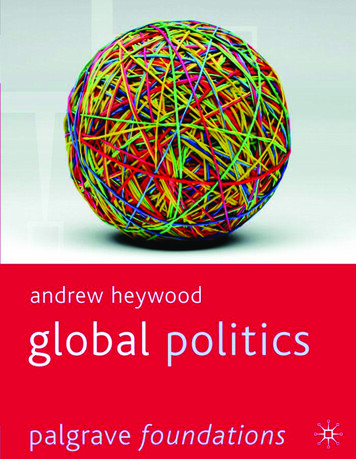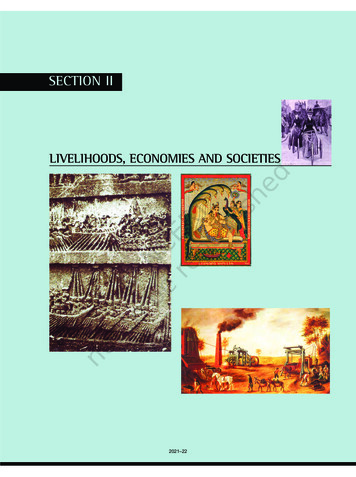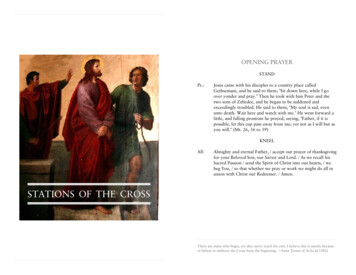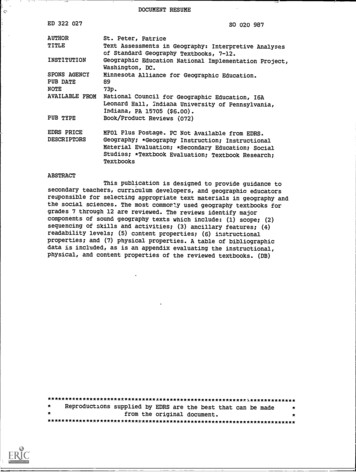
Transcription
The Making ofNew World SlaveryFrom the Baroque to the ------ROBIN BLACKBURNVVERSOLondon New York
For Barbara WebberContents'2 S \AcknowledgementsyiIntroduction: Slavery and ModernityjCivil Slavery and the Colonial StateShifting Identity and Racial SlaveryFrom the Baroque to the CreoleFirst published by Verso 1997 Robin Blackburn 1997All rights reservedThe right of Robin Blackburn to be identified as the authorof this work has been asserted by him inaccordance with the Copyright, Designs and Patents Act 1988Part OneI51220the selection of new world slavery31The Old World Background to New World SlaveryRome and the Christian Embrace of Slavery34VersoUK: 6 Meard Street, London WIV 3HRUSA: 180 Varick Street, New York NY 10014-4606Christian Resurgence and the Challenge of IslamFeudal Expansion and Ideologies of PersecutionSlavery in Iberia’s Christian KingdomsSlavery and the Slavs4449Verso is the imprint of New Left BooksThe Eclipse of Serfdom and the Rise of Agrarian CapitalismThe Bible, Slavery and the Nations of ManThe Mediterranean, the Atlantic and Black BondageAfricans and the Islamic Slave TradeConclusionISBN 1-85984-890-7British Library Cataloguing in Publication DataA catalogue record for this book is available from the British LibraryLibrary of Congress Cataloging-in-Publication DataBlackburn, RobinThe making of New World slavery : from the Baroque to the Creole /Robin Blackburn,p.cm.Includes index.ISBN 1-85984-890-71. Slavery—America—History. I. Title.HT1048.B56 1996306.3’62’097-dc2196-45603CIPTypeset by CentraCet, CambridgePrinted by Biddles Ltd, Guildford and King’s LynnIIIIIThe First Phase: Portugal and Africa425456647679§395Exploring the African CoastThe Beginnings of a Slave TradeThe Atlantic IslandsAfrican Slaves in the Peninsula991Q2jq8112Imperial Portugal, Africa, and Atlantic Civilization114Slavery and Spanish America127False Start in the CaribbeanSilver and Revenue: Exploitation without EnslavementSlaveholding in a Baroque EmpireProjects and Arguments137144147150
ContentsContentsIVIVThe Rise of Brazilian Sugar161La France AntarctiqueThe Takeoff of the Sugar EconomyThe Transatlantic Slave Trade and AfricaArguments over SlaverySlavery and the Looming Battle for the Americas164166174177181The Dutch War for Brazil and Africa185The West India CompanyThe Dutch in Brazil and AfricaThe Luso-Brazilian RecoilSources of Dutch WeaknessThe New Role of the Dutch188192198201211Part TwoVIVIIVIIIThe Making of English Colonial Slavery217The First ColoniesBarbados and the Rise of SugarThe Role of Captains and New MerchantsTobacco and SugarPlantation Labour, Slavery and Fear of Strange WomenCivil War: Empire and BondageThe Restoration and the Codification of Colonial SlaveryBacon’s Rebellion and Virginian SlaveryThe New Slavery and the Caribbean PlantationThe Glorious Revolution and the Colonies2,23229232234235243250256258261The Construction of the French Colonial System277An Experiment in MercantilismThe Testimony of Du TertreThe Code NoirRoyal Ambitions and the Spirit of Colonial AutonomyDynastic Calculation, Baroque Spectacle and ColonialDevelopment281287290292Racial Slavery and the Rise of the Plantation307Planters, Merchants, CaptainsPlantation Labour: From Indenture to SlaveryThe Supply of Slaves and the Turn to SlaveryThe New PlantationThe Plantation Regime and the Question of SecurityAlternatives to Slavery?312315326332344350298slavery and accumulationIX Colonial Slavery and the Eighteenth-Century BoomXVVXIXII371Europe and the AtlanticThe Slave Trade in the Eighteenth CenturyThe Pattern of Trade and Shipping377383395The Sugar Islands401Economics and Demography in the British CaribbeanThe French West IndiesAnglo-French Patterns of Colonial Trade .The Brilliance of French Creole Society404431444449Slavery on the Mainland457North America and the Reproduction of SlaverySlavery in Brazil’s Golden AgeSlavery in Spanish AmericaThe Lesser Producers and the Logic of the Plantation Trade459483494500New World Slavery, Primitive Accumulation and BritishIndustrializationMarkets in Africa and the New WorldProfits and InvestmentSectors of Investment and New Financial InstrumentsRaw MaterialsPlantation Products and the New World of ConsumptionWar, Colonies and IndustrializationThe Anglo-French Wars of 1793-1815: A T OF MAPS AND ILLUSTRATIONSThe Atlantic in the early colonial periodJacob Jordaens, Moses and ZipporahAlbert Eckourt, The Kongolese Envoy to RecifeRichard Ligon, A Map of Barbados, 1657The Coffee-ManJamaican music, from Hans Sloane, Voyage to the IslandsScold’s bridle and iron maskMap of the Caribbean, c. 1770Dam in Saint DomingueMap of the Americas, c. 1770232186218278308, 348325372402458
Introduction3 hi s book furnishes an account of the making of the European systemsX of colonial slavery in the Americas, and seeks to illuminate their rolein the advent of modernity. These slave systems were themselves radicallynew m character compared with prior forms of slavery, yet they wereassembled from apparently traditional ingredients. They became intenselycommercial, making Atlantic trade the pacemaker of global exchanges fromthe sixteenth century to the nineteenth, yet within the plantations moneyplayed an apparently modest - even negligible - role. Slave-grown tobaccosugar and cotton facilitated the birth of an expansive new world ofconsumption - one that was antithetical to slave rations and self-provision.The enterprises which battened on slave labour and produce embodied, asI will try to show, apparently advanced forms of technical and economicorganization.The acquisition of some twelve million captives on the coast of Africabetween 1500 and 1870 helped to make possible the construction of one ofthe largest systems of slavery in human history. The Atlantic slave tradeItself was to become remarkable for its businesslike methods as -well as itsThe Atlantic in the early colonial period million and a half captives died duringthe Middle Passage’ between Africa and the New World; an unknown, butlarge, number died prior to embarkation; and once in the New Worldbetween a tenth and a fifth of the slaves died within a year. Those whosurvived found their life drastically organized to secure from them as muchlabour as possible. The slaves met their own subsistence needs in one ortwo days’ work a week, working the remainder of the time for their ownersa rate of exploitation or surplus extraction with few parallels even amongother slave systems. In most parts of the Americas overwork, malnutritionand disease took a grim toll, and the slave labour force had to be replenishedy mrther slave purchases. During the eighteenth century the slaves ofBritish North America, unusually for any enslaved population, registered apositive natural growth rate, for reasons to be explored in Chapter XI. Thetotal slave population in the Americas reached around 330,000 in 1700nearly three million by 1800, and finally peaked at over six million in the1850s, probably exceeding the numbers of slaves in Roman Italy, who weremost numerous in the first century bc.African slaves were brought to the Americas in the first place at a timewhen the indigenous population was suffering a terrible catastrophe.Thousands of Africans helped to strengthen the colonial apparatus andperform both menial and supervisory tasks. Once plantation developmentwas under way, the slavery of the New World battened principally on thoseof African descent, with Indians being dispossessed and thrust to themargins, and Africans becoming highly concentrated in the most arduousemployments. The slavery of the Ancient World had been far morediversified, both m the pattern of employment and in its ethnic compositionwith Greek slave tutors, Egyptian slave administrators, English slaveservants, German slave labourers and many more (though very few black
4The Making of New World SlaveryAfricans). And while slave status was transmitted by inheritance in theAncient World, and in other slave societies, there were two constraints onthis as a source of reproduction of the slave labour force. First, slaves hadfew children; secondly, where they did have offspring there was usually agradual improvement in the status of their descendants: later generationsacquired some rights, or even benefited from manumission. Manumissiondid occur in the New World colonies, though it was most unusual whereplantation development was strongest. So far as the overwhelming majoritywas concerned. New World slavery was a curse that even the grandchildrenM the grandchildren of the original African captive found it exceedinglyyf difficult to escape. This was a strong, even unprecedented, species ofenslavement.But the slavery of the Americas not only presented many novel features.Ats development was associated with several of those processes which have\been held to define modernity: the growth of instrumental rationality, the/rise of national sentiment and the nation-state, racialized perceptions of(identity, the spread of market relations and wage labour, the developmentof administrative bureaucracies and modern tax systems, the growingsophistication of commerce and communication, the birth of consumersocieties, the publication of newspapers and the beginnings of pressadvertising, ‘action at a distance’ and an individualist sensi ty. TheAtlantic world of this epoch was -subject-to rapid, uneven but combineddevelopment. People separated by an ocean were brought into vitalrelationship with one another. The demand for sugar in London orAmsterdam helped to bring into being plantations in the Caribbean, whichin turn were supplied with provisions from North America and slaves fromAfrica. The dynamic of the Atlantic economy was sustained by new websof social trust, and gave birth to new social identities. It required businessplanning and methods for discounting risk; it was associated with distinc tive modern traditions of reflexive self-consciousness.Exploring the many ways in which American slavery proved compatiblewith elements of modernity will help to dispel the tendency of classicalsocial science - from Adam Smith to Ludwig von Mises, Auguste Comte toMax Weber - to identify slavery with traditionalism, patrimonialism andbackwardness. Weber raised interesting questions, but supplied the wronganswers: he did not realize that the slave population of North Americabecame naturally self-reproducing, while he believed that the slave colonieshad made a negligible contribution to European economic advance (theseerrors are tackled in Chapters XI and XII).' The colonial slave systemswere closely associated with the mercantilist epoch, and this helped tonourish the view that they were inherently rigid and dependent on statepatronage. Of course slavery is indeed a very ancient human institution,but it has also been highly flexible, and a great facilitator of social mobilityIntroduction5and adjustment or transition. The role it played in the transition tomodernity was not, therefore, out of character.Anthony Giddens has written that modernity characteristically effects a‘disembedding’ of individuals and institutions, which tears them away fromtheir traditional contexts. He sees money, as well as power or ideology, asa potent lever in this disembedding. Paul Gilroy has urged that some of themost distinctive structures and mentalities of modernity are already evidentin New World slavery. The Atlantic slave trade effected a protracted‘disembedding’ process, plunging the African slave into a new and unex pected system of social relations. Slavery existed in Africa prior to theAtlantic trade, and long continued to have a social meaning there whichwas very different to that prevailing in the Americas. In Africa slaves wereoften soldiers, for example, or recognized concubines. But the ‘new’ slavecould be sold, a circumstance which permitted a transformation in slavery,both in the Americas and, eventually, in many parts of Africa too, as thetransatlantic traffic grew in volume. Thus both institution and individualwere disembedded, as they were inserted into a new set of social relations.The slave trade itself employed a battery of economic devices ranging fromsophisticated patterns of credit and insurance to complex forms of barter.The New World slave was caught up in systems of social identification andsurveillance which marked him or her as a black, and closely regulatedtheir every action. The slave’s kinship identity was wiped out, and new tiesto ‘shipmates’, partners and relatives were vulnerable, since the slave couldbe sold at any time.While the slaves were subordinated to a rigid new role, the vortex ofAtlantic economy threw up disruptive new patterns of wealth and power.Control of the commodities produced by the slaves conferred great econ omic power - a power distributed between, and disputed by, states,merchants, bankers and slaveholders. The slaves were driven to work longhours and an intense rhythm; the appropriation of the fruits of their labourrequired the construction of an elaborate apparatus of supply, supervision,transport, processing and distribution, much of this engaging free labour.There was ample scope here for conflicts between different would-beappropriators, and between exploiters and exploited.Civil Slavery and the Colonial StateThe linjLhetW ilJiiQd niit and slavery gives us good reason to be attentive fhe rk side of progress. Modern social powers, as we now have manyreasons to know, can conduce to highly destructive and inhuman ends.Given the history of the twentieth century, it might seem that this lessonneeds no further elaboration. After the slaughter of the First World War,the grim record of colonial repression, the horrors of Stalinism and thegenocidal projects of Nazism, there can be few who believe that history is a
The Making of New World SlaveryIntroductionsimple forward march. From several points of view the history of theslavery of the Americas nevertheless merits our attention. We have yet toslough off all the ideologies and institutions produced in the era of racialslavery. Then again, the history of New World slavery, as I will try todemonstrate, sho sjhat ivil pciet , in a modern sense of the term, canitself powerfully - and, as it were, ‘spontaneously’ - contribute to highlydestructive patterns of human conduct. Writers of quite varied allegiancehaveldehtified theHisasfeH'SfTlIodernity with a disorder of the state. Suchphenomena as totalitarian violence and colonial war can be traced to thealienation of the state from civil society, to a fatal conjunction of bureau cratic rationality and fantasies of total power. In different ways this hasbeen argued by the sociologist Zygmunt Bauman and the then SartreanMarxist Ronald Aronson, in analyses of Nazism and Stalinism (Bauman)or Nazism, Stalinism and imperialism (Aronson) seen as forms of pure statepower. It can even be shown that the most destructive modern famineshave resulted as much - if not more - from state negligence as from theworking out of market forces. The tradition of writing about slavery in the Americas, from AdamSmith to Eric Williams, which associates it with the policies of ‘colonialmercantilism’ can also encourage a view that it was essentially a product ofstate voluntarism. These mercantilist policies owed much to the commercialprinciples of the Absolutist states and to the mimetic response of theircommercial rivals. So it could be concluded that the slave systems of theAmericas show, in an early form, the perils of state alienation from civilsociety. But the impressive scholarship on American slavery which hasaccumulated over the last half-century shows that this would be a quitemisconceived conclusion. The message of this history is, I will argue, thatthe s ontaneo dy5amic of iyib50ciely is adse-pf gnantAvith disaster andmayhem.For a considerable time the conjunction of slavery, colonialism, andmaritime power permitted the more advanced European states to skew theworld market to their own advantage. What has been called the ‘Europeanmiracle’ ' in fact depended not only on the control of intercontinentalexchanges but on the profits of slavery. The latter also helped to furnishsome of the conditions for a global industrial monopoly. The enormousgains achieved were based on the opportunities opened up by transferringforced labourers to parts of the globe under European control, andfavourably situated for supplying European markets with exotic produce.Blit monopolies decreed from European capitals were of limited efficacyunless they were backed up by a host of independent merchants andplanters, displaying entrepreneurial qualities.In the account which follows, it will be shown that the early modernstates bore their share of responsibility for the cruelties of the Atlantic slavetraffic and for the subsequent merciless and inhumane operation of theslave systems. The Portuguese monarchs promoted and licensed slavetrading in Africa from the mid fifteenth century. The Spanish authoritiesformally regulated the slave traffic via the asiento from the sixteenthcentury to the eighteenth. The Dutch, the British and the French all set upstate-sponsored slave trading concerns, with forts and trading posts inAfrica, in the seventeenth century. Once the captives arrived in the Americastheir conditions of life were - supposedly - regulated by public legislation.Rather more effectively, governments sought to regulate, and profit from,the commerce in slave produce.But this state sponsorship of slavery was closely linked to the dynamicof civil society - and as slavery flourished, so the state was confined to amore restricted role. It was not based on the abstraction or alienation ofthe colonial state from the dominant forces in colonial society. Quite thecontrary. The public au rities wererespondii in wavsJ will explore, to tthe insistent and specificpronlpfmgorpowerful social ctors. In Chapter IIthe royal regulation of Portugal’s spice trade with the EaS is contrasted tothe incipiently autonomous plantation and slave trade of the Atlantic. Arecent account argues that the first Atlantic sugar colony achieved takeoffin the late fifteenth century because of commercial and settler initiative:‘The plantations of Madeira . developed independently of Portuguesenational authority.’ If we turn to Spanish America, the introduction ofsome thousands of African slaves each year from the middle of the sixteenthcentury was a response to the eagerness of colonial planters, manufacturersand mine concessionaries to employ them - a process explored in ChapterIII. Referring to the use of African slaves, as well as other forms of labournot controlled by the colonial state in sixteenth-century Spanish America,Steve Stern writes:67These relationships had emerged in ‘civil society’, as expressions of ‘private’relations and coercions relatively free of direct sponsorship by the formal politicalstructure of the state. Slavery, personal lordship and contracted labor . .bound exploiter and exploited directly to one another. The colonial state, atvarious times and in different degrees, legally sanctioned, encouraged, and evenpurported to regulate such relationships. But the initiation, internal dynamicsand socioeconomic significance of these relationships reflected private or extraofficial initiative more than state edict.*In Spanish America the colonial state was to play a large and intrusive role,but - as we will see in Chapter III - this was greatly to cramp thedevelopment of plantation slavery. Matters turned out differently in Portu guese Brazil, but here - as I seek to explain in Chapter IV - the state wasless active in ordering colonial society - especially when it came to slavery.As Stuart Schwartz writes: ‘in the matter of slavery, the state and its officersare notably absent’. The process of colonization itself was to a greater or lesser extent statesponsored, and so were some ancillary varieties of enslavement. TheCastilian state acquired a mandate from the Pope to validate its conquest
8The Making of New World Slaveryof the New World. The Papacy sponsored the Treaty of Tordesillas (1494),which divided the world beyond Europe into separate spheres of Castilian(Spanish) and Portuguese colonization. Tordesillas ratified the Portuguesemonopoly of the African slave trade and endorsed Spain’s claim to thelion’s share of the as yet still barely ‘discovered’ Indies (North East Brazilwas to fall just inside the Portuguese sphere). While the Papacy allowed thePortuguese to sell African slaves to the Christian kingdoms of Spain, it didnot countenance their sale to Muslims, since enslavement was meant tolead to conversion. The Spanish doctrine of conquest affirmed that nativepeoples who resisted Castile’s divinely appointed role could be condemnedto slavery. However, the scope of enslavement practised by Spanishcolonists was to become the subject of a famous controversy; as we willsee, the monarch and his officials distrusted the greed and rapacity of theirown colonists. Eventually (as is described in Chapter III), the Spanishmonarch forbade the enslavement of the native inhabitants (though loop holes were left, since rebellious Indians could still be reduced to bondage).The imperial state also issued licences permitting the introduction and saleof African captives. If the slave plantation systems of the New World hadbeen constructed on the basis of a Spanish model, as some have wronglysupposed, then it would be necessary to acknowledge a much larger degreeof state sponsorship than there actually was. In fact the slave plantations ofSpanish America made only a very modest contribution to Atlantic com merce in the sixteenth and seventeenth centuries. It is true that Brazilianplantations became major producers in the last decades of the sixteenthcentury, and that the Portuguese Crown was at this time united with thatof Spain. But (as is explained in Chapter IV) Brazilian growth was toleratedrather than promoted by Madrid, and was anyway soon interrupted by aDutch invasion which the Spanish connection helped to provoke - circum stances recounted and analysed in Chapter V.The real takeoff of the plantation economies, it will be argued, tookplace in the seventeenth century. The New World ambitions of France, theNetherlands and England challenged the Iberian monopolies, and the Papalrulings on which they were based, with Protestant captains and colonistsoften playing a leading role. Neither France nor Britain could accept thePapal demarcation made at Tordesillas. Under the terms of the Treaty ofCateau-Cambresis in 1559 France, Spain and England made peace in,Europe while leaving open the precise status of territories ‘beyond the line’- that is, beyond the prime meridian passing through the Azores or Southof the Tropic of Cancer.* While Spain continued to assert its claims, Frenchand English privateers, many of them Protestant, disputed its commercialmonopoly. By this time a swarm of French adventurers and would-becolonists were staking their claim to trade or territory in the New World.The English soon followed. By the 1580s and 1590s the Flemish and Dutchsea beggars’ joined them without even respecting the line. Down to theTreaty of Ryswick in 1697 the territory ‘beyond the line’ - the whole of theIntroduction9Americas and most of the African coast - was to continue to be excludedfrom the terms of European peace treaties. The inability of the Europeanstates to come to terms concerning these crucial areas meant that theyremained a battleground, a sort of ‘wild West’ in which traders andcolonists founded a new order, eventually being obliged to defer to one orother of the colonial sheriffs. Without the tenacity and resources of thesecolonial entrepreneurs, little or nothing could be achieved.The theory of empire which the Portuguese, Spanish, French, Dutch andEnglish came to expound appealed to God-given rights, but with interestingdifferences of emphasis. The Portuguese emphasized their rights as ‘discov erers not so much of the land as of the sea routes between Europe and thenewly discovered coast; Portuguese captains were required to registernavigational details of their discoveries as well as marking them with astone cross. The Spanish monarch claimed to rule the Americas by a Godgiven right of conquest, so long as the ceremony of the ‘Requirement’demanding peaceful submission had been observed. Supposedly the Aztecand Inca rulers, having failed to respond and having obstructed theSpaniards’ free movement, had been conquered in a ‘just war’. The Frenchbelieved the Spanish ‘Requirement’ and conquest were a mockery ofChristian behaviour and violated the God-given natural rights of theindigenous peoples. The French, therefore, appeared in the New World asthe friends and allies of the natives, and supposedly established coloniesonly with their unforced consent. The Dutch asserted their right not simplyas naviptors but principally as traders; in contrast to the Iberian powers,they believed that there was a God-given natural right of all to sail the highseas in pursuit of trade, and to the better life that commerce brought withIt. Finally, the English laid stress on the fact that their colonists, ascultivators or ‘planters’, were making better use of the land than nativehunters-and-gatherers or colonial rivals, and thus enjoyed Divine sanction.This bare summary simply picks out the most salient feature in eachimperial ideology; in practice the various powers constantly sought toimitate one another’s successes and learn from their mistakes.’ But theircompetitive success naturally depended upon the resources and institutionsui‘dispose of. While the Spanish approach, at one extreme, washighly dependent on state initiative and control, the English formula, at theother, critically depended upon the initiative and competence of thecolonists themselves, albeit within the terms of some royal charter orbequest. In the various chapters of Part One it will be shown that African Islaves could be introduced to boost each and every one of these colonial)projects, though by far the most rewarding was to be the use of slaves in fplantation agriculture.'The workings of the slave systems were terribly destructive and oppres sive, but they came to display the routines of regular business. The slavetraders and their crews, and the slave masters and their overseers, workedm the expectation of earning a salary or making a profit. They proved
The Making of New World SlaveryIntroductioncapable of sadistic ferocity, and sought to crush slave resistance withdisplays of exemplary cruelty. But research into the impressively detailedrecords which the planters and merchants left behind reveals a convergenceon average rates of profit and standard methods of procedure. The pressuresof commercial competition helped to diffuse new techniques and todiscipline the wayward or self-indulgent planter. While most of the freeemployees implicitly consented to the degradation of black people, they didnot have to be motivated by racial hostility. Episodes of gratuitous violencewere far from unknown, because of the vulnerability of the slaves, but thesuccessful slave systems harnessed coercion to production and the mainten ance of order in a systematic way. Handbooks of plantation managementgenerally stressed that punishment should be meted out in a methodicaland predictable way. The overpacking of the ships in the Atlantic slavetrade, and the inadequate food and water provisions for the captives,produced much higher mortality rates than were found among freemigrants. But such methods were more profitable, since larger numbers ofslaves could be delivered on each voyage. The average workings.ofthe-skvesystems displayed something of the impersonality and functional logic ofmodern rgamzafionT Yet the slave plantations themselves were based onthe distmctiveTace-to-face relationship between overseer, driver and slaveconcerns entered it and the official slave trading companies were forced tothe margins. John Thornton writes of the early period: ‘although the statesof the Atlantic persistently sought to direct and control the trade, theirpurpose was really more to enhance their revenue by marginally distortingthe market’.” Thornton’s judgement is intended to apply to both Europeanand African states which, despite their different capacities, ultimately sharedan inability to dominate the slave traffic in a monopolistic fashion. It wasthe private initiative of merchants and planters that led to the successivelylarger-scale employment of slaves on the plantations on the Atlantic islands,in Brazil and in the Caribbean. The formula of American plantation slaveryachieved its most potent expression on the islands of the Eastern Caribbeanin the mid seventeenth century, at a time when none of them was effectivelyregulated by the metropolis, as we will see in Chapters VI and VII. At thistime Dutch mercantile skills, Portuguese and Brazilian knowledge of sugar making, and the enterprise of English and French planters and settlerscreated and multiplied large-scale plantations, relying on African slavelabour and harnessing the latest advances of commerce and manufacture.Karl Polanyi ascribed the ‘explosion of the slave trade’ to this ‘epochalevent as specific as the invention of the steam engine by James Watt some130 years later’.’”Recent research shows that even the large chartered slave tradingcompanies, such as England’s Royal African Company, found that they hadto respect market principles, and learn the precise wants and needs ofhundreds of suppliers on the African coast and thousands of purchasers inthe American colonies. After scrutinizing details of some eighty thousandtransactions recorded in the archives of the African Company, DavidGalenson concludes:10crew.The thoroughly commercial character of most Ne
commercial, making Atlantic trade the pacemaker of global exchanges from the sixteenth century to the nineteenth, yet within the plantations money played an apparently modest - even negligible - role. Slave-grown tobacco sugar and




